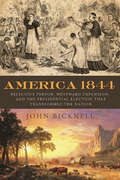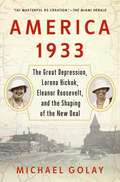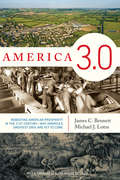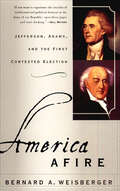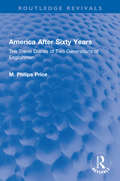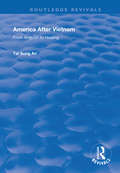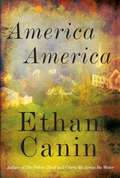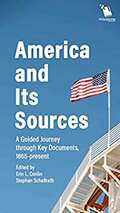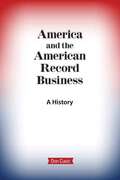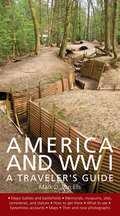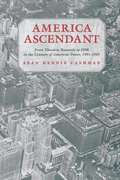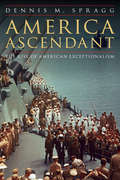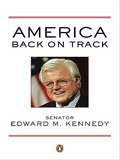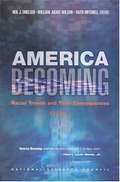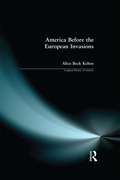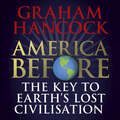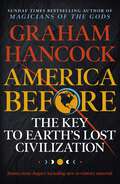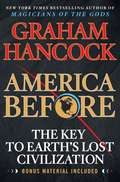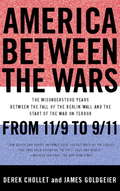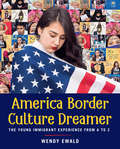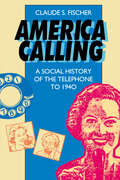- Table View
- List View
America 1844: Religious Fervor, Westward Expansion, and the Presidential Election That Transformed the Nation
by John BicknellThe year 1844 saw a momentous presidential election, religious turmoil, westward expansion, and numerous other interwoven events that profoundly affected the U.S. as a nation. Author and journalist John Bicknell details these compelling events in this unusual history book. He explains how the election of James K. Polk assured the expansion that brought Texas, California, and Oregon into the union. This took place amidst anti-Mormon and anti-Catholic violence, the belief in the imminent second coming of Christ, the murder of Joseph Smith, Charles Goodyear's patenting of vulcanized rubber, the near-death of President John Tyler in a freak naval explosion, and much more. All of these elements illustrate the competing visions of the American future and how Polk's victory cemented the vision of a continental nation.
America 1908: The Dawn of Flight, the Race to the Pole, the Invention of the Model T, and the Making of a Modern Nation
by Jim RasenbergerA breathtaking ride through the highs and lows of one spectacular, pivotal year in American history. As the earth turned toward the sun on the first morning of 1908, human flight remained, for most Americans, in the realm of myth and dream. But before the darkness fell on New Year's Eve at the end of the year, the Wright brothers would be worldwide celebrities, heralded as the first people in all of human history to conquer the sky. It was the year Teddy Roosevelt sent the Great White Fleet on a voyage around the globe, Robert Peary began his courageous dash to the North Pole, six automobiles left Times Square on an epic twenty-thousand-mile race to Paris, and Henry Ford introduced an oddly shaped new automobile called the Model T. It was a time of seemingly boundless innovation - everything was bigger, better, fast, and greater than ever before. In New York and Chicago, banks of high-speed elevators zipped through vertical shafts in the tallest buildings on earth. Pneumatic tubes whisked mail between far-flung post offices in minutes. Women cleaned their homes with amazing new devices called vacuums. And as American engineers cut a fifty-mile canal through the Isthmus of Panama, the very air buzzed with the imagined potential of new technology, including a "portable wireless telephone" that would someday allow people to talk while they walked. Meanwhile, the New York Giants battled the Chicago Cubs in one of the most thrilling seasons in baseball history, and a reluctant William Howard Taft was elected twenty-seventh president of the United States. By turns gripping and humorous, shocking and delightful, Jim Rasenberger's America, 1908 brings to life our nation as it was one hundred years ago, at a moment of delirious optimism and pride, a time when Americans believed that even the most intractable problems would soon be solved and that the future was bound to be better than the past. "What will the year 2008 bring us?" pondered the New York World on New Year's Day of 1908. "What marvels of development await the youth of tomorrow?" As Thomas Edison said later that year, "Anything, everything, is possible." Shedding new light on stories we thought we knew and telling fresh stories we can't believe we've never heard, American, 1908 is a rousing chronicle of a country on the brink of greatness - and a timely, thought-provoking glimpse at a younger America, even as we wonder what awaits us in the century ahead.
America 1933
by Michael GolayThe first account of the remarkable eighteen-month journey of Lorena Hickok, intimate friend of Eleanor Roosevelt, throughout the country during the worst of the Great Depression, bearing witness to the unprecedented ravages; an indelible portrait of an unprecedented crisis."All I can say is that these people have GOT to have clothing--RIGHT AWAY," Lorena Hickok wrote from drought-ravaged North Dakota in 1933. The cigar-smoking, poker-playing Hickok was the top woman news reporter of the day, and the intimate friend of Eleanor Roosevelt. Forced to abandon her thriving journalism career due to her closeness to the First Lady, Hickok was hired by FDR's right hand man Harry Hopkins to embark upon a grueling journey to the hardest hit areas across the country, during the harshest year of the Great Depression, to report back about the degree of devastation. Acclaimed historian Michael Golay draws on a trove of previously untapped original sources--including the moving and remarkably intimate almost daily letters between Hickok and Eleanor--to re-create that extraordinary journey, never before profiled. Hickok traveled almost nonstop for eighteen months, from January 1933 to August 1934--moving into the White House, to a room adjoining Eleanor's for her stays in between--driving through hellish dust storms, armed rebellion by coal workers in West Virginia, and a near revolution by Midwest farmers, writing a series of deeply empathetic and searing reports to Hopkins and letters to Eleanor that constitute an unparalleled record of the worst economic crisis ever to afflict the country, and which profoundly influenced the nature of the FDR's unprecedented relief efforts. This beautifully written account brings reveals at last Hickok's pivotal contribution, as well as shedding important new light on her intense but ill-fated relationship with Eleanor and the forces that inevitably came between them.
America 1933: The Great Depression, Lorena Hickok, Eleanor Roosevelt, and the Shaping of the New Deal
by Michael GolayThe first account of the remarkable eighteen-month journey of Lorena Hickok, intimate friend of Eleanor Roosevelt, throughout the country during the worst of the Great Depression, bearing witness to the unprecedented ravaged.During the harshest year of the Great Depression, Lorena Hickok, a top woman news reporter of the day and intimate friend of Eleanor Roosevelt, was hired by FDR's right hand man Harry Hopkins to embark upon a grueling journey to the hardest hit areas across the country to report back about the degree of devastation. Distinguished historian Michael Golay draws on a trove of original sources--including moving and remarkably intimate almost daily letters between Hickok and Eleanor Roosevelt--as he re-creates that extraordinary journey. Hickok traveled almost nonstop for eighteen months, from January 1933 to August 1934, driving through hellish dust storms, rebellion by coal workers in Pennsylvania and West Virginia, and a near revolution by Midwest farmers. A brilliant observer, Hickok's searing and deeply empathetic reports to Hopkins and her letters to Mrs. Roosevelt are an unparalleled record of the worst economic disaster in the history of the country. Historically important, they crucially influenced the scope and strategy of the Roosevelt Administration's unprecedented relief efforts. America 1933 reveals Hickok's pivotal contribution to the policies of the New Deal, and sheds light on her intense but ill-fated relationship with Eleanor Roosevelt and the forces that inevitably came between them.
America 3.0
by James C. Bennett Michael J. LotusAmerica's greatest days are yet to come. We are in a painful transition period. Our government is crushingly expensive, failing at its basic functions, and unable to keep its promises. It does not work and it cannot continue as it is. But the inevitable end of big government does not mean the end of America. It only means the end of one phase of American life. America is poised to enter a new era of freedom and prosperity. The cultural roots of the American people go back at least fifteen centuries, and make us individualistic, enterprising, and liberty-loving. The Founding generation of the United States lived in a world of family farms and small businesses, America 1.0. This world faded away and was replaced by an industrialized world of big cities, big business, big labor unions and big government, America 2.0. Now America 2.0 is outdated and crumbling, while America 3.0 is struggling to be born. This new world will bring immense productivity, rapid technological progress, greater scope for individual and family-scale autonomy, and a leaner and strictly limited government. America has made one major transition already, and industrial America became an economic colossus. We are now making a new transition, which will surprise many Americans, and astonish the world.
America Afire: Jefferson, Adams, and the First Contested Election
by Bernard A. WeisbergerAmerica Afire is the powerful story of the election of 1800, arguably the most important election in America's history and certainly one of the most hotly disputed. Former allies Adams and Jefferson, president versus vice president, Federalist versus Republican, squared off in a vicious contest that resulted in broken friendships, scandals, riots, slander, and jailings in the fourth presidential election under the Constitution.
America After Sixty Years: The Travel Diaries of Two Generations of Englishmen (Routledge Revivals)
by M. Philips PriceFirst Published in 1936 America After Sixty Years presents the travel diaries of two generations of Englishmen, W. E. Price, and his son M. Philips Price. Part I of the book contains W. E. Price’s American journey and throws light on topics like undercurrents of Canadian politics; life in Chicago just before the great fire; journey to the Yosemite Valley etc. Part II of the book deals with W. E Price and his wife’s American tour in 1878 and Part III is about M. Philips Price’s own journey to America with his wife during the New Deal. This part of the diary is a pen-picture of the autumn and early winter of 1934 and his impressions of different parts of America like New York, New England, Chicago, California, New Mexico, and the Federal Capital under the New Deal. This book is a must read for any reader interested to know about American history through travel diaries.
America After Vietnam: From Anguish to Healing (Routledge Revivals)
by Tai Sung AnFirst published in 1997, this volume explores the twenty years it has taken the United States to decide where Vietnam belongs on its mental landscape, as indicated by the establishment of official diplomatic relations between the two countries on August 5, 1995. Having won the Cold War, but lost a skirmish in Vietnam, America’s defeat can now be set in context against subsequent campaigns in Afghanistan, Angola, El Salvador, Eritrea, Nicaragua, Somalia, Sudan and elsewhere which suggest that the best any outsider can expect by intervening in Third World domestic conflicts is a hugely expensive, bloody stalemate. Tai Sung-An identifies that, despite America’s painful, deep and very expensive involvement in Vietnam for a lengthy two decades, Americans fought, failed and left while remaining ignorant of the most elementary knowledge of Vietnam, symptomatic of a cultural gap, isolationism and even intellectual complacency.
America America
by Ethan CaninIt is the early 1970s; Nixon is in the White House and Corey Sifter, the young son of working-class parents, is befriended by the powerful Metarey family, whose patriarch is a kingmaker in the world of New York state politics. Corey becomes a yard-boy on the Metarey's grand estate, and soon, through the family's generosity, a student at a private boarding school. Before long, he is a confidant of the Metareys and an aide to the great New York Senator Henry Bonwiller as he runs for the Democratic nomination for President of the United States. But as the Bonwiller presidential campaign gains momentum a crime is committed, and Corey is forced to reconcile his part in a complex tangle of morality, politics, gratitude, love and loyalty. Set against the backdrop of the Vietnam War and during one of the most turbulent eras of twentieth-century US politics,America Americapossesses the mastery of pace and voice of classic American fiction. Canin has written a magnificent novel about ambition and family, politics and crime, sex and love, small-town life and big-time power - and, ultimately, how vanity, greatness and tragedy combine to change history and fate.
America And Its Sources: A Guided Journey Through Key Documents, 1865-present
by Erin ConlinAmerica and Its Sources: A Guided Journey through Key Documents, 1865-present is an innovative sourcebook designed for non-majors, ESL students, and other students who struggle with large amounts of reading. Through 14 focused units, the editors guide students from important post-1865 documents to major sources from contemporary America. Each unit includes a brief introduction to the era, unit questions, 5 expertly edited primary sources with overviews and guiding questions, and a unit review. This affordable sourcebook offers students the essential tools they need to examine and analyze primary sources without overwhelming them with lengthy and difficult texts.
America And The American Record Business: A History
by Don CusicIn America and the American Record Business, Don Cusic weaves the history of the music, the business and the technology that has created the contemporary recording industry against a backdrop of American history. The music, business is the music, the business and the technology rolled together and Cusic chronicles the development of each and how they are intertwined. The development of pop, country music, blues, jazz and other forms of commercial music, along with the creation of major record labels and the development of the technology that captured the music is told against the background of American history.
America And Wwi: A Traveler's Guide
by Mark D. Van EllsFOLLOWING THE DOUGHBOY FROM THE HOME FRONT TO THE WESTERN FRONT--AND MAPPING THE MANY MEMORIALS BUILT IN HIS HONOR
America Ascendant: From Theodore Roosevelt to FDR in the Century of American Power, 1901-1945
by Sean Dennis CashmanA lively tour of the United States in the first half of the twentieth century, America Ascendant traces the development of America's tremendous industrial power and its commercial deployment, at home and abroad. Emphasizing the contributions of those charismatic presidents who shaped the future of politics-- Theodore Roosevelt, Woodrow Wilson, and Franklin Delano Roosevelt--the book also covers pioneers such as Henry Ford and the Wright brothers, whose technological contributions transformed societies the world over. The book investigates the phenomena that threatened America's ascendance--the Great Red Scare of 1917- 20 and the rout of organized labor, the Great Crash of 1929 and the searing depression years, and the apartheid policies that undermined American democratic ideals. Moreover, Sean Dennis Cashman sets the American story within the dramatic context of the rise and fall of political empires in Europe and Asia and two devastating world wars. Enriching the volume is an integrated account of the American cultural scene, replete with such figures as Ernest Hemingway, Frank Lloyd Wright, George Gershwin, Louis Armstrong, Billie Holiday, Charlie Chaplin, and D. W. Griffith. Imaginatively conceived, America Ascendant once again reveals Sean Dennis Cashman's flair for bringing American history to life with all its triumphs, drama, and ambiguities.
America Ascendant: The Rise of American Exceptionalism
by Dennis M. SpraggAmerica Ascendant vividly portrays the global crisis that brought the media and the government into an alliance that changed the course of American and world history. President Franklin D. Roosevelt organized an extraordinary partnership between the U.S. government and America&’s media outlets to communicate to the reluctant and isolationist American public the nature of the threat that World War II posed to the nation and the world. The coalition&’s aim was to promote the concept of American exceptionalism and use it to galvanize the public for the government&’s cause.America Ascendant details the efforts of many prominent individuals and officials to harness the collective energy of the nation and guide the United States throughout World War II then describes its aftermath and the Cold War period. Dennis M. Spragg demonstrates how the news and entertainment of American broadcasters such as David Sarnoff, William Paley, and Elmer Davis helped rally the American people to fashion a new liberal democratic order to stop the global spread of Communism. This media-government alliance, however, was not achieved without difficulty. Spragg highlights the competing visions and personalities that clashed, as media and government leaders tried to develop the paradigm that ultimately shifted American cultural and political thought. Throughout this searching history he sheds light on the underappreciated coordination between the media and the government to establish a liberal democratic world order and demonstrates why American exceptionalism still matters.
America Back on Track
by Senator Edward M. KennedyFrom one of America's most respected progressive voices comes an inspiring vision of reform and renewal In a Senate career spanning more than four decades, Edward M. Kennedy has become one of the most authoritative voices in American politics. His first major book in more than twenty years, America Back on Track argues that our nation has departed more deeply from its fundamental ideals than at any time in modern history. From a dangerous foreign policy to the threats against constitutional checks and balances, Kennedy tackles the country's gravest concerns and charts a course toward a stronger, freer, and fairer America. A provocative call to action, this will be read by everyone seeking political clarity in these tumultuous times.
America Becoming: Racial Trends and Their Consequences
by National Research CouncilThe 20th Century has been marked by enormous change in terms of how we define race. In large part, we have thrown out the antiquated notions of the 1800s, giving way to a more realistic, sociocultural view of the world. The United States is, perhaps more than any other industrialized country, distinguished by the size and diversity of its racial and ethnic minority populations. Current trends promise that these features will endure. Fifty years from now, there will most likely be no single majority group in the United States. How will we fare as a nation when race-based issues such as immigration, job opportunities, and affirmative action are already so contentious today?In America Becoming, leading scholars and commentators explore past and current trends among African Americans, Hispanics, Asian Americans, and Native Americans in the context of a white majority. This volume presents the most up-to-date findings and analysis on racial and social dynamics, with recommendations for ongoing research. It examines compelling issues in the field of race relations, including: Race and ethnicity in criminal justice. Demographic and social trends for Hispanics, Asian Americans, and Native Americans. Trends in minority-owned businesses. Wealth, welfare, and racial stratification. Residential segregation and the meaning of "neighborhood." Disparities in educational test scores among races and ethnicities. Health and development for minority children, adolescents, and adults. Race and ethnicity in the labor market, including the role of minorities in America's military. Immigration and the dynamics of race and ethnicity. The changing meaning of race. Changing racial attitudes.This collection of papers, compiled and edited by distinguished leaders in the behavioral and social sciences, represents the most current literature in the field. Volume 1 covers demographic trends, immigration, racial attitudes, and the geography of opportunity. Volume 2 deals with the criminal justice system, the labor market, welfare, and health trends, Both books will be of great interest to educators, scholars, researchers, students, social scientists, and policymakers.
America Before the European Invasions (Longman History of America)
by Alice Beck KehoeBeginning with the immigrants from Asia, through inventions of agriculture, cities and kingdoms, American First Nations are integral to the history of the United States. They explored the continent, pioneered its waterways and mountain passes, cleared forests, irrigated deserts, and ranched its great plains.Invading Europeans justifies their conquests by denying the evidence of American Indian civilisations. Using her familiarity with the archaeological remains and remnants, Alice Kehoe builds a fascinating prehistory, highlighting the research puzzles along the way.This book presents an enthralling look at the depth and diversity of American history - before the Europeans and the deadly epidemics they brought with them decimated whole nations.
America Before: A new investigation into the mysteries of the human past by the bestselling author of Fingerprints of the Gods and Magicians of the Gods
by Graham Hancock***THE SUNDAY TIMES TOP TEN BESTSELLER***'Hancock's books provide a fascinating, alternative version of prehistory. America Before, detailed and wide-ranging, turns what was myth and legend into a new story of the past.' Daily MailWas an advanced civilization lost to history in the global cataclysm that ended the last Ice Age? Graham Hancock, the internationally bestselling author, has made it his life's work to find out -- and in America Before, he draws on the latest archaeological and DNA evidence to bring his quest to a stunning conclusion.We've been taught that North and South America were empty of humans until around 13,000 years ago - amongst the last great landmasses on earth to have been settled by our ancestors. But new discoveries have radically reshaped this long-established picture and we know now that the Americas were first peopled more than 130,000 years ago - many tens of thousands of years before human settlements became established elsewhere.Hancock's research takes us on a series of journeys and encounters with the scientists responsible for the recent extraordinary breakthroughs. In the process, from the Mississippi Valley to the Amazon rainforest, he reveals that ancient 'New World' cultures share a legacy of advanced scientific knowledge and sophisticated spiritual beliefs with supposedly unconnected 'Old World' cultures. Have archaeologists focussed for too long only on the 'Old World' in their search for the origins of civilization while failing to consider the revolutionary possibility that those origins might in fact be found in the 'New World'?America Before: The Key to Earth's Lost Civilisation is the culmination of everything that millions of people have loved in Hancock's body of work over the past decades, namely a mind-dilating exploration of the mysteries of the past, amazing archaeological discoveries and profound implications for how we lead our lives today.(P)2019 Hodder & Stoughton Limited
America Before: A new investigation into the mysteries of the human past by the bestselling author of Fingerprints of the Gods and Magicians of the Gods
by Graham Hancock***THE SUNDAY TIMES TOP TEN BESTSELLER***'Hancock's books provide a fascinating, alternative version of prehistory. America Before, detailed and wide-ranging, turns what was myth and legend into a new story of the past.' Daily MailWas an advanced civilization lost to history in the global cataclysm that ended the last Ice Age? Graham Hancock, the internationally bestselling author, has made it his life's work to find out -- and in America Before, he draws on the latest archaeological and DNA evidence to bring his quest to a stunning conclusion.We've been taught that North and South America were empty of humans until around 13,000 years ago - amongst the last great landmasses on earth to have been settled by our ancestors. But new discoveries have radically reshaped this long-established picture and we know now that the Americas were first peopled more than 130,000 years ago - many tens of thousands of years before human settlements became established elsewhere.Hancock's research takes us on a series of journeys and encounters with the scientists responsible for the recent extraordinary breakthroughs. In the process, from the Mississippi Valley to the Amazon rainforest, he reveals that ancient 'New World' cultures share a legacy of advanced scientific knowledge and sophisticated spiritual beliefs with supposedly unconnected 'Old World' cultures. Have archaeologists focussed for too long only on the 'Old World' in their search for the origins of civilization while failing to consider the revolutionary possibility that those origins might in fact be found in the 'New World'?America Before: The Key to Earth's Lost Civilisation is the culmination of everything that millions of readers have loved in Hancock's body of work over the past decades, namely a mind-dilating exploration of the mysteries of the past, amazing archaeological discoveries and profound implications for how we lead our lives today.
America Before: A new investigation into the mysteries of the human past by the bestselling author of Fingerprints of the Gods and Magicians of the Gods
by Graham Hancock***THE SUNDAY TIMES TOP TEN BESTSELLER***'Hancock's books provide a fascinating, alternative version of prehistory. America Before, detailed and wide-ranging, turns what was myth and legend into a new story of the past.' Daily MailWas an advanced civilization lost to history in the global cataclysm that ended the last Ice Age? Graham Hancock, the internationally bestselling author, has made it his life's work to find out -- and in America Before, he draws on the latest archaeological and DNA evidence to bring his quest to a stunning conclusion.We've been taught that North and South America were empty of humans until around 13,000 years ago - amongst the last great landmasses on earth to have been settled by our ancestors. But new discoveries have radically reshaped this long-established picture and we know now that the Americas were first peopled more than 130,000 years ago - many tens of thousands of years before human settlements became established elsewhere.Hancock's research takes us on a series of journeys and encounters with the scientists responsible for the recent extraordinary breakthroughs. In the process, from the Mississippi Valley to the Amazon rainforest, he reveals that ancient 'New World' cultures share a legacy of advanced scientific knowledge and sophisticated spiritual beliefs with supposedly unconnected 'Old World' cultures. Have archaeologists focussed for too long only on the 'Old World' in their search for the origins of civilization while failing to consider the revolutionary possibility that those origins might in fact be found in the 'New World'?America Before: The Key to Earth's Lost Civilisation is the culmination of everything that millions of readers have loved in Hancock's body of work over the past decades, namely a mind-dilating exploration of the mysteries of the past, amazing archaeological discoveries and profound implications for how we lead our lives today.
America Before: The Key to Earth's Lost Civilization
by Graham HancockWas an advanced civilization lost to history in the global cataclysm that ended the last Ice Age? Graham Hancock, the internationally bestselling author, has made it his life's work to find out--and in America Before, he draws on the latest archaeological and DNA evidence to bring his quest to a stunning conclusion. <P><P>We’ve been taught that North and South America were empty of humans until around 13,000 years ago – amongst the last great landmasses on earth to have been settled by our ancestors. But new discoveries have radically reshaped this long-established picture and we know now that the Americas were first peopled more than 130,000 years ago – many tens of thousands of years before human settlements became established elsewhere. <P><P>Hancock's research takes us on a series of journeys and encounters with the scientists responsible for the recent extraordinary breakthroughs. In the process, from the Mississippi Valley to the Amazon rainforest, he reveals that ancient "New World" cultures share a legacy of advanced scientific knowledge and sophisticated spiritual beliefs with supposedly unconnected "Old World" cultures. Have archaeologists focused for too long only on the "Old World" in their search for the origins of civilization while failing to consider the revolutionary possibility that those origins might in fact be found in the "New World"? <P><P>America Before: The Key to Earth's Lost Civilization is the culmination of everything that millions of readers have loved in Hancock's body of work over the past decades, namely a mind-dilating exploration of the mysteries of the past, amazing archaeological discoveries and profound implications for how we lead our lives today. <P><b>A New York Times Bestseller</b>
America Betrayed: How a Christian Monk Created America & Why the Left Is Determined to Destroy Her
by David HorowitzAmerica is now engulfed in a crisis that goes to the very foundations of its democracy. To destroy Americans&’ pride in their heritage and undermine their will to defend it, the attacks on America&’s heritage begin with malicious slanders intended to turn the American dream of equality and freedom into a &“white supremacist&” nightmare. We are told America, from its inception, has been a &“racist&” nation that treats minorities as less than human. We are told America deserves to be destroyed. This destructive lie is now the official doctrine of the Biden White House, the &“woke&” Pentagon, the Democratic Senate, and the curricula of American schools. America Betrayed restores the true history of America&’s achievements and its role as a beacon of freedom. Framed by an account of Martin Luther&’s history and ideas, David Horowitz demonstrates that racial progress in America originates not from Leftist policy but from its founding ideals. America Betrayed is a history and a manifesto focused on the current war to save our country and restore the dignity and freedom of the individual.
America Between the Wars: From 11/9 to 9/11; The Misunderstood Years Between the Fall of the Berlin Wall and the Start of the
by James Chollet Derek GoldgeierOn November 9, 1989, the Berlin Wall collapsed, taking the Cold War down with it. The next twelve years passed in a haze of self-congratulation, Republican confusion, and angst, and economic prosperity?until they ended abruptly with a stunning catastrophe on September 11, 2001. "In America Between The Wars," Derek Chollet and James Goldgeier blend deep expertise with broad access to both partiesOCO political and policy establishments to find out how?and why?America failed to recognize that when we became the sole superpower with responsibility for the worldOCOs oversight, we overlooked how the new world actually worked.
America Border Culture Dreamer: The Young Immigrant Experience from A to Z
by Wendy EwaldFirst- and second-generation immigrants to the US from all around the world collaborate with renowned photographer Wendy Ewald to create a stunning, surprising catalog of their experiences from A to Z. In a unique collaboration with photographer and educator Wendy Ewald, eighteen immigrant teenagers create an alphabet defining their experiences in pictures and words. Wendy helped the teenagers pose for and design the photographs, interviewing them along the way about their own journeys and perspectives.America Border Culture Dreamer presents Wendy and the students' poignant and powerful images and definitions along with their personal stories of change, hardship, and hope. Created in a collaboration with Al-Bustan Seeds of Culture, this book casts a new light on the crucial, under-heard voices of teenage immigrants themselves, making a vital contribution to the timely national conversation about immigration in America.
America Calling: A Social History of the Telephone to 1940
by Claude S. FischerThe telephone looms large in our lives, as ever present in modern societies as cars and television. Claude Fischer presents the first social history of this vital but little-studied technology—how we encountered, tested, and ultimately embraced it with enthusiasm. Using telephone ads, oral histories, telephone industry correspondence, and statistical data, Fischer's work is a colorful exploration of how, when, and why Americans started communicating in this radically new manner.Studying three California communities, Fischer uncovers how the telephone became integrated into the private worlds and community activities of average Americans in the first decades of this century. Women were especially avid in their use, a phenomenon which the industry first vigorously discouraged and then later wholeheartedly promoted. Again and again Fischer finds that the telephone supported a wide-ranging network of social relations and played a crucial role in community life, especially for women, from organizing children's relationships and church activities to alleviating the loneliness and boredom of rural life.Deftly written and meticulously researched, America Calling adds an important new chapter to the social history of our nation and illuminates a fundamental aspect of cultural modernism that is integral to contemporary life.
